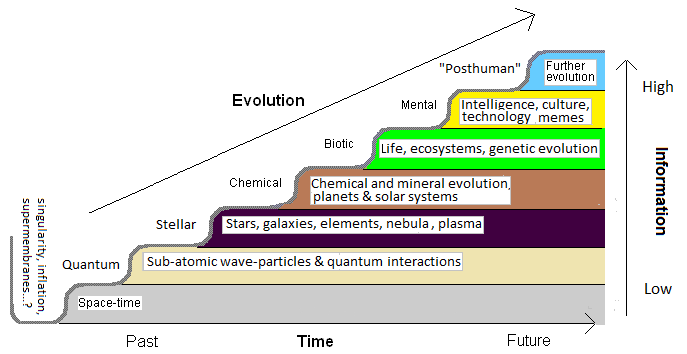
Simplistic diagram of Cosmic Evolution, by me (M Alan Kazlev), Creative Commons Attribution License. MAK110914
| Cosmic Evolution | ||
| Evolution | Cosmic Evolution |
| Big History Deep Time | Palaeos | |||
| Time | Deep Time | Abiotic | Cosmos | Science |
Cosmic Evolution |
Cosmic Evolution |
 Simplistic diagram of Cosmic Evolution, by me (M Alan Kazlev), Creative Commons Attribution License. MAK110914 |
The above very simplistic diagram of cosmic evolution sums up the ideas presented on the previous pages, such as Erich Jantsch's Self-Organizing Universe, Thomas Berry, Brian Swimme, Connie Barlow, Michael Dowd, et al's Great Story or Epic of Evolution, Eric Chaisson's Cosmic Evolution, Fred Spier, David Christian, Cynthia Stokes Brown, and Bill Bryson's Big History, and Theodore Modis' growth of complexity. Many other similar accounts could also be mentioned here; e,g, Sri Aurobindo's integral vedanta, Teilhard de Chardin's evolutionary theology, Edward Haskell et al's unified science, Oliver Resier's Cosmic Humanism, Arthur M. Young's theory of process, Ken Wilber's Integral Theory, Transhumanism, Singularitanism, etc. Apart from the very real differences between some of these philosophies and worldviews, which I haven't gone into here, all present a similar evolutionary theme. This is shown in the above diagram, although without the metaphysical element found in Aurobindo, Teilhard, etc, which is outside the scope of empirical science to comment on. The basic theme, presented in the above diagram, shows the evolution of matter, life, and mind in the cosmos, with two arbitrary axii, physical time (horizontal) and creative complexity and variation (vertical). Time is shown from left (the Big Bang, where the laws of physics break down) to right (the unknown future. The relation between the two is shown in the above diagram. Here the X-axis (horizontal) is time. The Y-axis, would be increase in complexity, variation, creativity, and, consciousness. Note that evolution in this context (the diagonal line) is cosmic evolution, the cosmos as the emergence of progressive complexity and creative structures through time.
Evolution is here represented by the emergence of progressively more complex or diverse and varied information structures, shown here as progressive emergent structures or fields of creative unfolding: Space-Time, Quantum, Stellar (or Astronomic, or Atomic), Chemical, Biotic, Mental, and - because there is no reason why evolution should end with rational self-intelligence - a future hypothetic stage of "Posthuman". Although on the one hand these progressive structures or breakthroughs trace an emergent linear curve (or chain of sigmoid curves, for each new evolutionary template), all the previous stages continue to evolve and develop, even whilst new ones appear. Also, the various configurations of space-time interact with each other, creating further evolutionary configurations. MAK110914
Although this diagram shows a linear ascending scale in the manner of the Graeco-Medieval Great Chain of Being [1], this presentation is deliberately simplistic, due to the limitations of the dimensional page (or screen). In fact each emergent stage follows its own evolutionary direction, independent of the others. So rather than a two dimensional diagram, it can be shown as a seven (or however many) dimension one. A better way of representing the process of cosmic evolution shown above would be in terms of a dendrogram or tree diagram, a representation of cosmic phylogeny, as follows:
This diagram still does not take into account the interplay of macro- (collective, environmental) and micro- (individual) scale evolution described by Jantsch, which adds further levels of synergy and complexity. Or feedback between different orders of evolution, such as organic life driving mineral evolution. On the quantum scale the problem of observation may even mean that consciousness affects the universe. Hence the above diagram would need to be supplemented by a back and forth feedback between different emergent orders of complexity. Also each higher level does not only rely on the immediately preceeding one; life for example is only possible because of the thermonuclear energy of the sun (and other stars in the universe, in the case of astrobiology), which is the stellar level; whilst future AI (artificial intelligence) may constitute a posthuman machine intelligence that based on chemical and mineral, rather than biotic, resources (although nanotech may also be based on microscopic biological machines, such as bacterial flagella.) Each of the stages of evolutionary emergence also interacts with the other stages, but with many (indeed, an indefinite number of) converging and diverging levels, rather than just two. MAK111014 revised 120709
| Big History Deep Time | Cosmos | The Self-Organizing Universe |
Page MAK111014, edited RFVS111024, last revised MAK120709